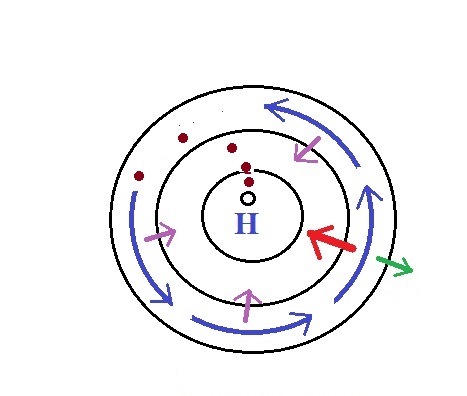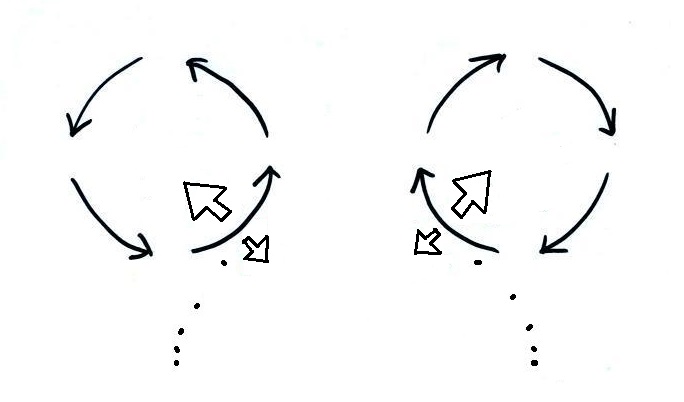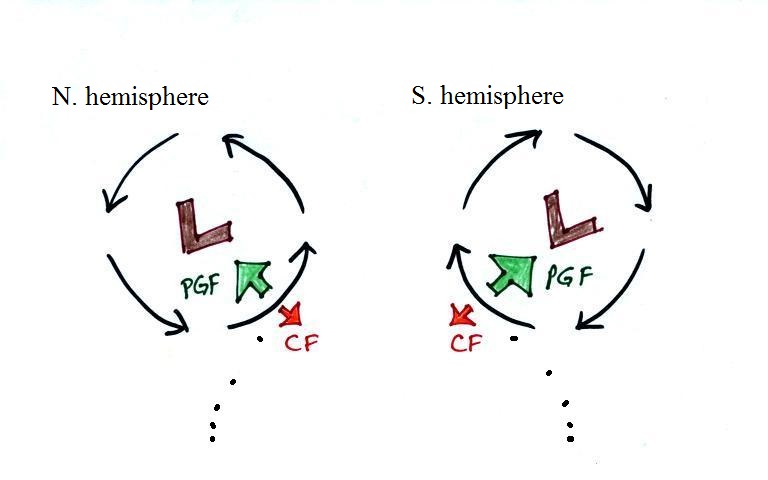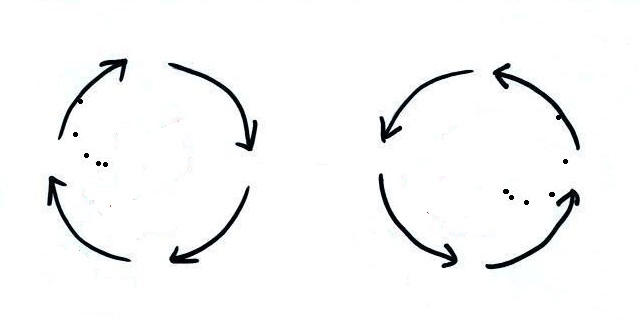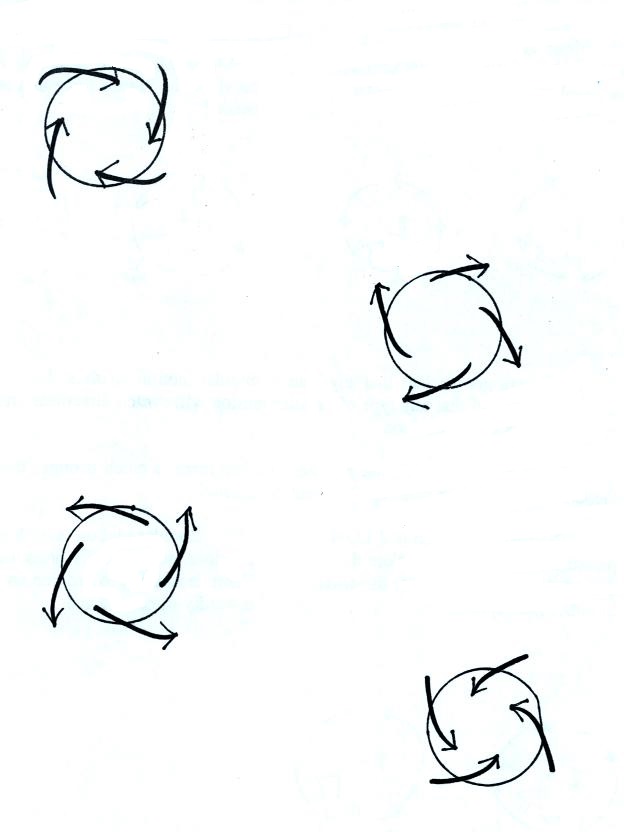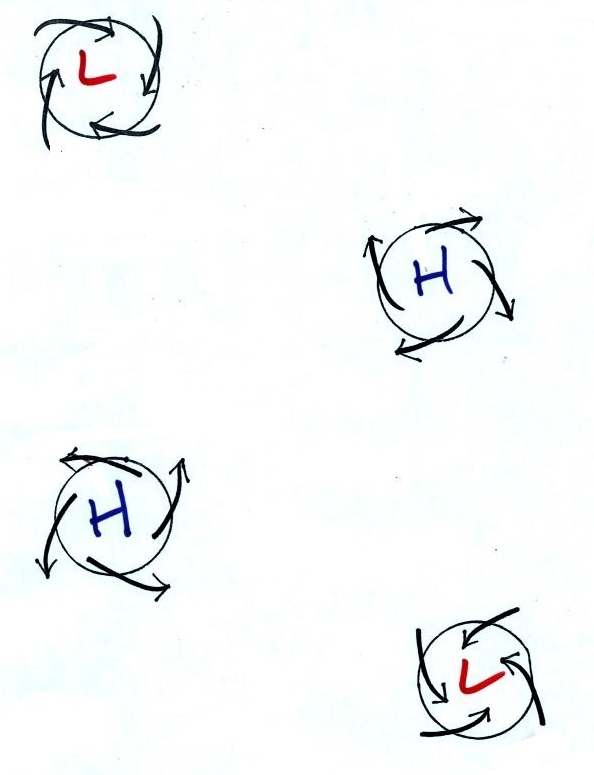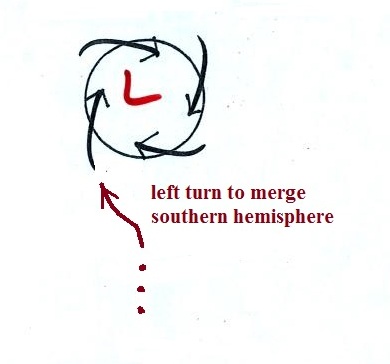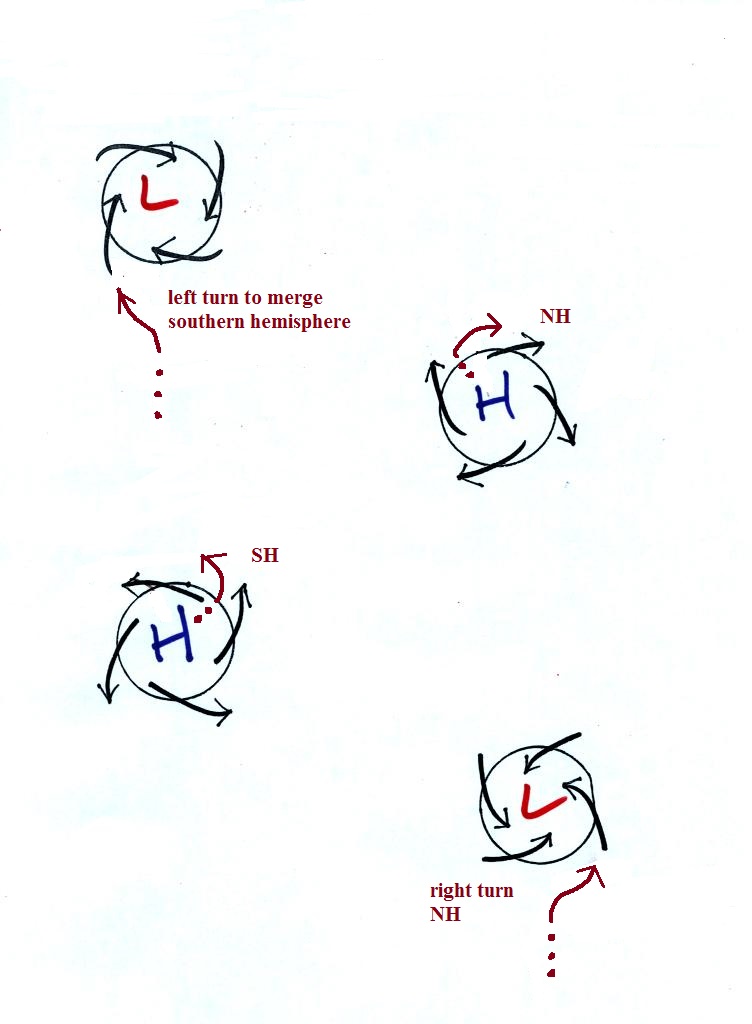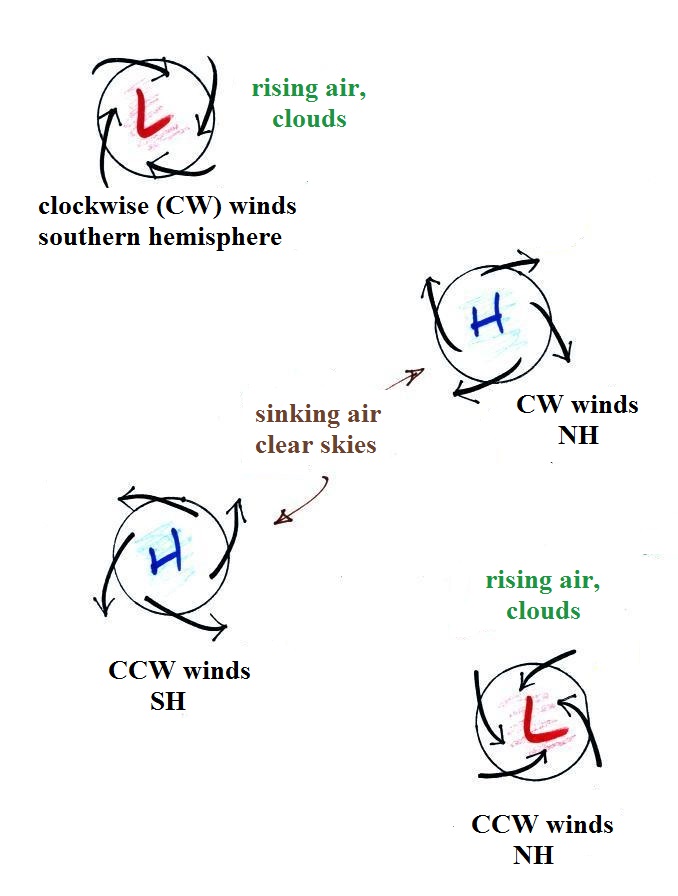Monday, Apr. 1, 2019
Dessa "Skeleton
Key" (3:45), "551"
(4:14), "5
out o 6" (3:31), "Sadie Hawkins"
(3:29), "Mineshaft
II" (4:42)
You'll need page 125,
page 126, page 127, page 128, page 129, and page 130 from the
ClassNotes for today's class.
Step #5 - Upper level winds, low pressure, northern
hemisphere
Next we'll be looking at the upper level winds that develop around
circular centers of high and low pressure.

We start with some stationary air at the bottom of the
picture. Because the air is stationary, there is no
Coriolis force. There is a PGF force,
however. The PGF at
Point 1 starts stationary air moving toward the center of low
pressure (just like a rock would start to roll downhill).
The dots show the initial motion
A rock would roll right into the center of the picture.
Once air starts to move, the CF
causes it to turn to the right (because this is a northern
hemisphere chart). As the wind speeds up the CF strengthens. The wind
eventually ends up blowing parallel to the contour lines and
spinning in a counterclockwise direction. Note that the
inward PGF is stronger than
the outward CF. This
results in a net inward force,
something that is needed anytime wind blows in a circular path.
Upper level winds spin counterclockwise around low pressure
in the northern hemisphere.
Step #6 - Upper level winds, low pressure, southern
hemisphere
We start again with some stationary air at Point 1 in this
figure. The situation is very similar. Air starts to
move toward the center of the picture but then takes a left hand
turn (the CF is to the left
of the wind in the southern hemisphere). The winds end up
spinning in a clockwise direction around low in the southern
hemisphere. The directions of the PGF, CF,
and the net inward force
are all shown in the picture.
Upper level winds spin clockwise around low pressure in the
southern hemisphere.
Step #7 - Upper level winds, high pressure, northern
hemisphere
Here initially stationary air near the center of the picture
begins to move outward in response to an outward pointing
pressure gradient force (PGF
is pointing toward low pressure which is on the edges of the
picture). Once the air starts to move, the Coriolis force
(CF) will cause the wind to
turn to the right. The dots show the initial outward
motion and the turn to the right. The wind ends up blowing
in a clockwise direction around the high. The inward
pointing CF is stronger
than the PGF so there is a
net inward force here just
as there was with the two previous examples involving low
pressure. An inward force is needed with high pressure
centers as well as with centers of low pressure. An inward
force is needed anytime something moves in a circular path.
Step #8 - Upper level winds, high pressure, southern
hemisphere
This is a southern hemisphere upper level center of high
pressure. The air starts to move outward again but
this time takes a left hand turn and ends up spinning
counterclockwise. The net force is inward again.
Upper level winds review
Here's a quick review of much of what we have
covered.
Winds
spin counterclockwise around L pressure in the
northern hemisphere then switch direction and spin
clockwise around L pressure in the southern
hemisphere. I think by just remembering a
couple of things you can figure this out rather than
just trying to memorize it.
The pressure
gradient will start stationary air moving toward low pressure
(just like a rock placed on a slope will start to move
downhill)
The PGF can start
stationary air moving. The PGF always points
toward low pressure, so the direction of the
initial motion will always be toward low pressure.
The dots in the figure above show this initial motion
and its in toward the center of the picture.
These must both be centers of Low pressure.
Once the air starts moving the wind will turn to the
right or left depending on the hemisphere. This
is the effect of the Coriolis force, the CF
turns wind to the right in the northern hemisphere
and to the left in the southern hemisphere
(remember to always look down stream).
The
northern hemisphere winds are shown at left in the
figure above, the southern hemisphere winds are
shown at right. The inward pointing force is
always stronger than the outward force so that there
is a net inward pointing force.
This initial motion is outward away from the center in the
two figures below.
The outward moving air takes a right turn in the left
figure above, a left turn in the right figure (you may need to
rotate the picture so that you are looking downstream, in the
direction the wind is blowing to clearly see the left hand
turn).
Friction and surface winds
Next we'll try to understand why friction causes surface winds
to blow across the contour lines (always toward low pressure).
With surface winds we need to take into account the PGF, the CF, and
the frictional force (F). That means we'll need some rules
for the direction and strength of the frictional force.
Friction arises with surface winds because the air is blowing
across (rubbing against) the earth's surface.

You're probably somewhat familiar with the effects of
friction. If you stop pedaling your bicycle on a flat road
you will slow down and eventually come to a stop due to air
friction and friction between the tires and road surface.
Friction always acts to slow a moving object it must point in a
direction opposite the motion.
The strength of the frictional force depends on wind speed.
The faster you try to go the harder it becomes because of
increased wind resistance. It's harder to ride on a rough
road than on a smooth road surface. In the case of air there
is less friction when wind blows over the ocean than when the air
blows over land. If the wind isn't blowing there isn't any
friction at all.
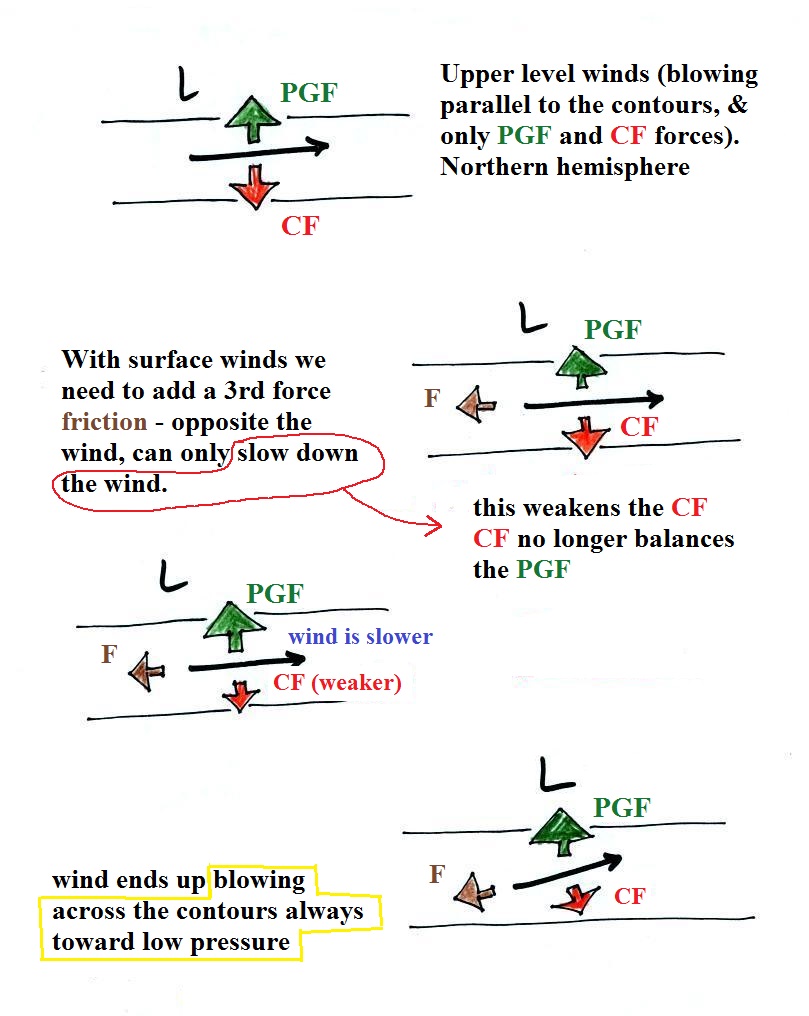
The top figure (page
129 in the ClassNotes) shows upper level winds
blowing parallel to straight contours. The PGF and CF
point in opposite directions and have the same strength (the
fact that there are only two forces present tells you these
are upper level winds). Note the CF is to the right of
the wind, this is a northern hemisphere case. The total
force, the net force, is zero. The winds would blow in a
straight line at constant speed.
We add friction in the second picture. It points in a
direction opposite the wind and acts to slow the wind
down.
Slowing the wind weakens the CF and it can no longer balance
the PGF (3rd figure). The stronger PGF causes the wind
to turn and start to blow across the contours toward
Low. This is shown in the 4th figure.
Step #10 - Surface winds blowing around H & L
pressure in the N. & S. hemispheres.
I think you'll be surprised at how easy it
is to determine whether each of the figures below (p. 129 in
the ClassNotes) is a surface center of H or L pressure,
found in the N or S hemisphere, and whether rising
or sinking air motions/clear or cloudy skies would be
associated with each figure.
Key point to remember:
surface winds blow across the contours always toward
low pressure.
It should be very easy to figure
out which two of the figures above are surface centers of low
and high pressure.
Next to determine whether each figure is in the northern
or southern hemisphere we will imagine approaching the upper left
figure in an automobile. We'll imagine it's a traffic circle
and the arrows represent cars instead of wind.
You're approaching the traffic
circle, what direction would you need to turn in order to
merge with the other cars. In this case it's
left. That left turn is the Coriolis force at work
and tells you this is a southern hemisphere map.
The remaining examples are shown below
Converging winds cause air to rise. Rising air expands and
cools and can cause clouds to form. Clouds and stormy
weather are associated with surface low pressure in both
hemispheres. Diverging winds created sinking wind motions
and result in clear skies.
Somethings change when you move form the northern to the
southern hemisphere (direction of the spinning winds).
Sometimes stay the same (winds spiral inward around centers of low
pressure in both hemispheres, rising air motions are found with
centers of low pressure in both hemispheres).







